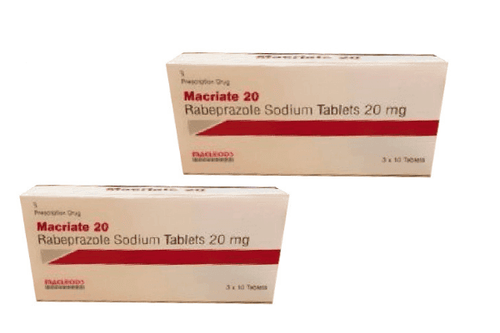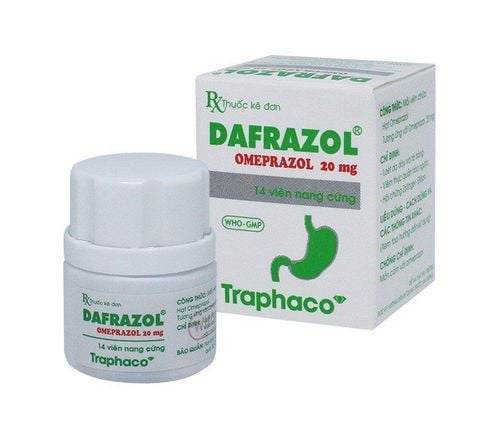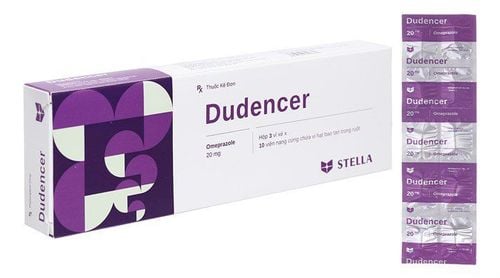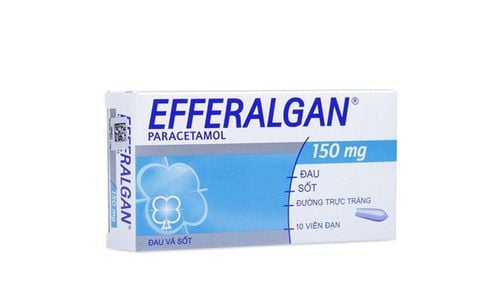This is an automatically translated article.
Ommax 20 has the main active ingredient Omeprazole with the effect of inhibiting gastric acid secretion. Ommax 20 is a product of Domesco Medical Import-Export Joint Stock Company. So what are the specific uses of Ommax 20?
1. What is Ommax 20?
What is Ommax 20? Ommax 20 has the main active ingredient Omeprazole (in the form of enteric-coated microparticles 8.5% Omeprazol) with a content of 20mg. Ommax 20 is a product of Domesco Medical Import-Export Joint Stock Company (Vietnam).
The active ingredient Omeprazole in Ommax 20 is a benzimidazole with substituents attached, similar in structure and effect to Pantoprazole, Lansoprazole and Esomeprazole. Omeprazole inhibits gastric acid secretion through inhibition of the hydrogen/potassium adenosine triphosphatase (H+/K+ ATPase) enzyme system, also known as the proton pump, in the parietal cells of the stomach. Ommax 20 has no effect on acetylcholine or histamine receptors. In addition, the active ingredient Omeprazole can also inhibit Helicobacter pylori in patients with duodenal ulcer and/or reflux esophagitis. Combining Ommax 20 with some antibiotics (such as Clarithromycin or Amoxicillin) can kill H.pylori bacteria along with healing ulcers and long-term remission.
2. What are the effects of Ommax 20?
What does Ommax 20 do? Ommax 20 is indicated in the following cases:
Adults: Treatment of duodenal ulcers, stomach ulcers; Prevent recurrence of peptic ulcer; Treating or preventing peptic ulcers associated with NSAID use; Treatment of gastroesophageal reflux; In combination with antibiotics according to appropriate regimens for the treatment of peptic ulcers caused by Helicobacter pylori; Treatment of Zollinger-Ellison syndrome; Children: Children over 1 year old and weighing over 10kg: Treatment of esophageal reflux, relief of heartburn symptoms caused by acid reflux; Children 4 years and older: In combination with appropriate antibiotics for the treatment of peptic ulcers caused by Helicobacter pylori. Ommax 20 is contraindicated in the following cases:
Patients with hypersensitivity to Omeprazol or any ingredient in the drug; Concomitant use of Ommax 20 and Nelfinavir is contraindicated.
3. Dosage of the drug Ommax 20
Dosage of Ommax 20 recommended for adults:
Treatment of duodenal ulcer: 1 tablet of Ommax 20 1 time / day for 2 weeks, can be extended for 2 more weeks if the symptoms are not completely cured; Treatment of stomach ulcers: 1 tablet of Ommax 20 x 1 time / day for 4 weeks, can be extended for 4 more weeks if the disease does not improve; Prevention of recurrence of duodenal and gastric ulcers: 1 Ommax 20 tablet once a day, can be increased to 2 Ommax 20 tablets if treatment fails; Kill Helicobacter pylori causing peptic ulcers: Ommax 20 combined with Clarithromycin 500mg and Amoxicillin 1000mg: 2 times a day for 7 days; Ommax 20 combined with Clarithromycin 250mg (or 500mg) and Metronidazol 400mg (or 500mg or tinidazol 500mg): 3 times a day for 1 week; 2 tablets of Ommax 20 combined with Amoxicillin 500mg and Metronidazol 400mg (or 500mg or Tinidazol 500mg): Take 3 times a day for a week; Treatment of peptic ulcers caused by non-steroidal anti-inflammatory drugs: Take 1 tablet of Ommax 20 x 1 time/day for 4 weeks; Prevention of peptic ulcers caused by non-steroidal anti-inflammatory drugs in at-risk patients (over 60 years of age, history of peptic ulcer, history of upper gastrointestinal bleeding): Ommax 20 x 1 time/day ; Esophagitis due to gastroesophageal reflux: 1 tablet of Ommax 20 x 1 time/day for 4 weeks; Treatment of Zollinger-Ellison syndrome: The starting dose is 3 Ommax tablets 20 x 1 time/day, the usual dose ranges from 20-120mg/day. Patients taking doses higher than 80mg should be divided into 2 doses per day; Patients with hepatic impairment: The dose of Ommax 20 may have to be reduced, 10-20mg/day is recommended; Patients with renal impairment: No dose adjustment of Ommax 20 is necessary; Elderly people: No need to adjust the dose of Ommax 20. Dosage of Ommax 20 for children:
Children over 1 year old and weighing 10-20kg: Dose 1⁄2 tablets of Ommax 20 x 1 time/day; Children over 2 years old and weighing over 20kg: 1 dose of Ommax 20 x 1 time/day; Children over 4 years old can use Ommax 20 to treat peptic ulcers caused by Helicobacter pylori bacteria according to the following recommendations: Weight 15-30kg: Omeprazol 10mg combined Clarithromycin 7.5mg/kg and Amoxicillin 25mg/kg: Each drink twice a day for 1 week; Weight 31-40kg: Omeprazol 20mg combined with Clarithromycin 7.5.mg/kg and Amoxicillin 750mg: Take 2 times a day for 1 week; Weight over 40kg: Omeprazol 20mg, combination of Clarithromycin 500mg and Amoxicillin 1000mg: Take 2 times a day for 1 week.
4. Side effects of the drug Ommax 20
Common side effects when using Ommax 20 are:
Headache, drowsiness, dizziness; Diarrhea, nausea, vomiting; Stomachache; Constipation, abdominal distension. Rare side effects of Ommax 20:
Insomnia, sensory disturbances, fatigue; hives , itchy skin or rash; transient increase in transaminases. Some rare unwanted effects when using Ommax 20:
Sweating, peripheral edema; Hypersensitivity manifestations such as angioedema, fever or anaphylaxis; Decreased blood cell count, agranulocytosis or autoimmune hemolytic anemia; Reversible confusion, agitation, depression, appearance of hallucinations in the elderly, hearing disorders; gynecomastia in men; Candida infection, dry mouth; Hepatitis with or without jaundice, hepatic encephalopathy in liver failure; Bronchospasm; Joint pain, muscle pain; Interstitial nephritis; Increased risk of gastrointestinal infections because Ommax 20 inhibits gastric acid secretion.
5. Drug interactions of Ommax 20
Drug interactions of Ommax 20 may occur during use as follows:
Ommax 20 may increase the concentration of Cyclosporin in the blood when used concurrently; Ommax 20 increases the effect of antibiotics in combination regimens to eradicate Helicobacter pylori; Ommax 20 reduces the metabolism of drugs that are metabolized through the cytochrome P450 enzyme system, leading to increased blood levels of drugs, including Diazepam, Phenytoin and Warfarin. Ommax 20 inhibits the metabolism of Warfarin but has little effect on bleeding time; Ommax 20 enhances the anticoagulant effect of Dicoumarol; Ommax 20 reduces the metabolism of Nifedipine by at least 20%, thus possibly increasing the effect of Nifedipine; Clarithromycin inhibits the metabolism of Ommax 20 and doubles the concentration of Omeprazole in the blood; Ommax 20 is a decrease in gastric acid that affects (increases or decreases) the absorption of drugs depending on gastric pH; Concomitant administration of Ommax 20 with Atazanavir reduces plasma concentrations of Atazanavir; The interaction between Clopidogrel and Omeprazole may reduce exposure to the active metabolite; Co-administration of Ommax 20 and Tacrolimus may increase the serum concentration of Tacrolimus; Ommax 20 may reduce the absorption of vitamin B12 (cyanocobalamin) with long-term treatment; Concomitant use of Ommax 20 with Posaconazole, Erlotinib, Ketoconazole and Itraconazole may reduce the absorption and reduce the effect of those drugs; Methotrexate blood levels may increase when administered concomitantly with Ommax 20 . Patients need to inform the doctor about herbal medicines, health care products so that the doctor knows and considers drug interactions, ensuring safety for users.
6. Pay attention when using Ommax 20
Attention when using Ommax 20 drug in the following cases:
Omeprazole may mask symptoms and delay diagnosis in patients with gastric malignancy, so suspected cases need to be diagnosed. exclude before taking Ommax 20 . Using Ommax 20 may increase the risk of gastrointestinal infections, including Salmonella or Campylobacter infections. Ommax 20 prolonged use may increase the risk of fractures, especially in elderly patients. Long-term use of Ommax 20 can reduce blood magnesium, so it is necessary to monitor magnesium levels during drug administration. Co-administration of Atazanavir with Ommax 20 may reduce plasma concentrations of Atazanavir, therefore the dose of Atazanavir must be increased to 400 mg and Ritonavir 100 mg, while the dose of Omeprazol should not exceed 20 mg/day. Proton pump inhibitors such as Ommax 20 have been associated with subacute lupus erythematosus. If lesions occur, especially in areas exposed to sunlight, accompanied by joint pain, the patient should promptly notify the doctor and stop taking Ommax 20. Ommax 20 may cause dizziness, drowsiness, so it should be used with caution when driving a vehicle and operating machinery. There are no data on the toxic effects of Ommax 20 on the fetus. However, the use of Ommax 20 during pregnancy should only be considered when absolutely necessary. Because Omeprazole is distributed into breast milk, consideration should be given to either discontinuing Ommax 20 or breastfeeding. Ommax 20 has the main active ingredient Omeprazole with the effect of inhibiting gastric acid secretion. To ensure the effectiveness of treatment and avoid unwanted side effects, patients need to carefully read the instructions for use contained in the medicine box and consult a doctor, professional pharmacist before use.
Follow Vinmec International General Hospital website to get more health, nutrition and beauty information to protect the health of yourself and your loved ones in your family.













